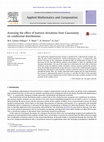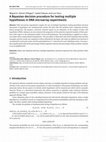Papers by Miguel A. Gomez-Villegas
Journal of Multivariate Analysis, Feb 1, 2014
Communications in Statistics, Aug 1, 2005
The display of the data by means of contingency tables is used in different approaches to statist... more The display of the data by means of contingency tables is used in different approaches to statistical inference, for example, to broach the test of homogeneity of independent multinomial distributions. We develop a Bayesian procedure to test simple null hypotheses versus bilateral alternatives in contingency tables. Given independent samples of two binomial distributions and taking a mixed prior distribution, we calculate the posterior probability that the proportion of successes in the first population is the same as in the second. This posterior probability is compared with the p-value of the classical method, obtaining a reconciliation between both results, classical and Bayesian. The obtained results are generalized for r × s tables.
Communications in Statistics, Feb 11, 2008
It is shown that a multivariate exponential power distribution is a scale mixture of normal distr... more It is shown that a multivariate exponential power distribution is a scale mixture of normal distributions, with respect to a probability distribution function, when its kurtosis parameter belongs to the interval (0,1]. The corresponding mixing probability distribution function is presented. This result is used to design a Bayesian hierarchical model and an algorithm to generate samples of the posterior distribution; these are applied to a problem of Quantitative Genetics.
Statistics & Probability Letters, 2004
In this paper the asymptotic relationship between the classical p-value and the infimum (over all... more In this paper the asymptotic relationship between the classical p-value and the infimum (over all unimodal and symmetric distributions) of the posterior probability in the point null hypothesis testing problem, is analyzed. It is shown that the ratio between the infimum and the classical p-value has an equivalent asymptotic behaviour to the hazard rate of the sample model.
Expert Systems With Applications, Sep 1, 2011
In this work, we evaluate the sensitivity of Gaussian Bayesian networks to perturbations or uncer... more In this work, we evaluate the sensitivity of Gaussian Bayesian networks to perturbations or uncertainties in the regression coe¢ cients of the network arcs and the conditional distributions of the variables. The Kullback-Leibler divergence measure is used to compare the original network to its perturbation. By setting the regression coe¢ cients to zero or non-zero values, the proposed method can remove or add arcs, making it possible to compare di¤erent network structures. The methodology is implemented with some case studies.

Journal of Multivariate Analysis, Oct 1, 2008
To evaluate the impact of model inaccuracies over the network's output, after the evidence propag... more To evaluate the impact of model inaccuracies over the network's output, after the evidence propagation, in a Gaussian Bayesian network, a sensitivity measure is introduced. This sensitivity measure is the Kullback-Leibler divergence and yields different expressions depending on the type of parameter to be perturbed, i.e. on the inaccurate parameter. In this work, the behavior of this sensitivity measure is studied when model inaccuracies are extreme, i.e. when extreme perturbations of the parameters can exist. Moreover, the sensitivity measure is evaluated for extreme situations of dependence between the main variables of the network and its behavior with extreme inaccuracies. This analysis is performed to find the effect of extreme uncertainty about the initial parameters of the model in a Gaussian Bayesian network and about extreme values of evidence. These ideas and procedures are illustrated with an example.
Communications in Statistics, 1992
... Copyright O 1992 by Marcel Dekker, Inc. Page 2. ... Casella and Berger (1987) reconciling evi... more ... Copyright O 1992 by Marcel Dekker, Inc. Page 2. ... Casella and Berger (1987) reconciling evidence in the one-sided testing problem and state that discrepancies in the point null test problem to the use of a mixed prior distribution. ...

Applied Mathematics and Computation, Jul 1, 2013
The multivariate exponential power family is considered for n-dimensional random variables, Z, wi... more The multivariate exponential power family is considered for n-dimensional random variables, Z, with a known partition Z ðY; XÞ of dimensions p and n À p, respectively, with interest focusing on the conditional distribution YjX. An infinitesimal variation of any parameter of the joint distribution produces perturbations in both the conditional and marginal distributions. The aim of the study was to determine the local effect of kurtosis deviations using the Kullback-Leibler divergence measure between probability distributions. The additive decomposition of this measure in terms of the conditional and marginal distributions, YjX and X, is used to define a relative sensitivity measure of the conditional distribution family fYjX ¼ xg. Finally, simulated results suggest that for large dimensions, the measure is approximately equal to the ratio p=n, and then the effect of non-normality with respect to kurtosis depends only on the relative size of the variables considered in the partition of the random vector.
Journal of Multivariate Analysis, Oct 1, 2002
This paper shows a practical and easy to compute generalization of the linear dynamic model, made... more This paper shows a practical and easy to compute generalization of the linear dynamic model, made by assuming a continuous elliptical joint distribution for the parameters and errors. Updated distribution and probabilistic characteristics of the current and future vector of state and observations are given. As a particular simple submodel, the one with a multidimensional exponential power initial distribution is developed. An example to show its use is given.
Journal of Multivariate Analysis, Feb 1, 2006
Two conditions are shown under which elliptical distributions are scale mixtures of normal distri... more Two conditions are shown under which elliptical distributions are scale mixtures of normal distributions with respect to probability distributions. The issue of finding the mixing distribution function is also considered. As a unified theoretical framework, it is also shown that any scale mixture of normal distributions is always a term of a sequence of elliptical distributions, increasing in dimension, and that all the terms of this sequence are also scale mixtures of normal distributions sharing the same mixing distribution function. Some examples are shown as applications of these concepts, showing the way of finding the mixing distribution function.
Communications in Statistics, Feb 25, 2002
In the problem of testing the point null hypothesis R o : 8 = 8 0 versus Hl : () =1 80, with a pr... more In the problem of testing the point null hypothesis R o : 8 = 8 0 versus Hl : () =1 80, with a previously given prior density for the parameter e, \Ve propose the following metbodology: tú fix an interval of radius é around ea and assign a• prior mass, ;;0 , tú Ho computed by tbe density iL(O) over tbe interval (0 0-E, Oo + E), spreading the remainder, 1-;;0 , over H 1 according tú r. (O). It is shown that for Lindley's paradox, the Normal model with sorne different priors ancI Darwin-Fisher 's exarnple, this procedure rnakes the posterior probability of Ho and the p-vd lue rnatching better than if the prior rnass assigned to Ho is 0.5.
Communications in Statistics, Dec 31, 2002
This paper proposes a matrix variate generalization of the power exponential distribution family,... more This paper proposes a matrix variate generalization of the power exponential distribution family, which can be useful in generalizing statistical procedures in multivariate analysis and in designing robust alternatives to them. An example is added to show an application of the generalization.

Statistical Applications in Genetics and Molecular Biology, 2014
DNA microarray experiments require the use of multiple hypothesis testing procedures because thou... more DNA microarray experiments require the use of multiple hypothesis testing procedures because thousands of hypotheses are simultaneously tested. We deal with this problem from a Bayesian decision theory perspective. We propose a decision criterion based on an estimation of the number of false null hypotheses (FNH), taking as an error measure the proportion of the posterior expected number of false positives with respect to the estimated number of true null hypotheses. The methodology is applied to a Gaussian model when testing bilateral hypotheses. The procedure is illustrated with both simulated and real data examples and the results are compared to those obtained by the Bayes rule when an additive loss function is considered for each joint action and the generalized loss 0-1 function for each individual action. Our procedure significantly reduced the percentage of false negatives whereas the percentage of false positives remains at an acceptable level.
Statistics, Aug 1, 2009
... DOI: 10.1080/02331880802505173 Miguel A. Gómez–Villegas a * , Paloma Maín a & Luis Sanz a... more ... DOI: 10.1080/02331880802505173 Miguel A. Gómez–Villegas a * , Paloma Maín a & Luis Sanz a pages 379-391. Available online: 02 Jul 2009. ...
Communications in Statistics, Sep 10, 2008
Communications in Statistics, Apr 30, 2001
The referred paper (named herein “the Paper”) is about the multivariate power exponential distrib... more The referred paper (named herein “the Paper”) is about the multivariate power exponential distribution and certainly gives a wide, systematic, ordered study of this distribution, showing also some applications and examples. Our work with the power exponential distribution began before 1988 and has given rise to papers such as (1) and (2), as well as to the thesis (3). We started with the univariate power exponential distribution (studied in (4), (5), (6)) which may by put (see (6)) as
Procedia - Social and Behavioral Sciences, 2010
The Multivariate Exponential Power family is considered for n-dimensional random variables, Z, wi... more The Multivariate Exponential Power family is considered for n-dimensional random variables, Z, with a known partition Z (Y,X) of dimensions p and n-p, respectively. An infinitesimal variation of any parameter produces both conditional and marginal distributions perturbations. The aim of our study is to determine the local effect of kurtosis deviations by means of the Kullback-Leibler divergence measure between probability distributions. The additive decomposition of this measure in terms of the conditional and marginal distributions, Y X and X, has been used to define the relative sensitivity of the conditional distributions family {Y X = x}. The obtained results show that, for large dimensions, it is nearly p/n.
Information Sciences, Aug 1, 2014
We introduce a methodology for sensitivity analysis of evidence variables in Gaussian Bayesian ne... more We introduce a methodology for sensitivity analysis of evidence variables in Gaussian Bayesian networks. Knowledge of the posterior probability distribution of the target variable in a Bayesian network, given a set of evidence, is desirable. However, this evidence is not always determined; in fact, additional information might be requested to improve the solution in terms of reducing uncertainty. In this study we develop a procedure, based on Shannon entropy and information theory measures, that allows us to prioritize information according to its utility in yielding a better result. Some examples illustrate the concepts and methods introduced.
Communications in Statistics, Feb 22, 2007
This article develops a method for computing the sensitivity analysis in a Gaussian Bayesian netw... more This article develops a method for computing the sensitivity analysis in a Gaussian Bayesian network. The measure presented is based on the Kullback-Leibler divergence and is useful to evaluate the impact of prior changes over the posterior marginal density of the target variable in the network. We find that some changes do not disturb the posterior marginal density of interest. Finally, we describe a method to compare different sensitivity measures obtained depending on where the inaccuracy was. An example is used to illustrate the concepts and methods presented.









Uploads
Papers by Miguel A. Gomez-Villegas